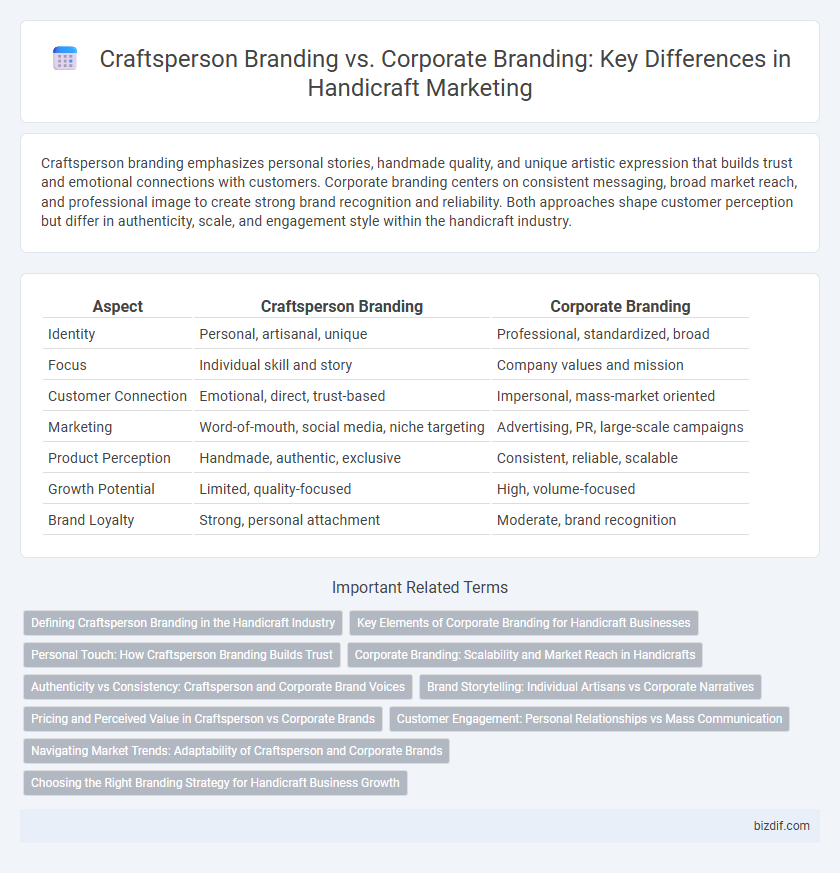Craftsperson branding emphasizes personal stories, handmade quality, and unique artistic expression that builds trust and emotional connections with customers. Corporate branding centers on consistent messaging, broad market reach, and professional image to create strong brand recognition and reliability. Both approaches shape customer perception but differ in authenticity, scale, and engagement style within the handicraft industry.
Table of Comparison
| Aspect | Craftsperson Branding | Corporate Branding |
|---|---|---|
| Identity | Personal, artisanal, unique | Professional, standardized, broad |
| Focus | Individual skill and story | Company values and mission |
| Customer Connection | Emotional, direct, trust-based | Impersonal, mass-market oriented |
| Marketing | Word-of-mouth, social media, niche targeting | Advertising, PR, large-scale campaigns |
| Product Perception | Handmade, authentic, exclusive | Consistent, reliable, scalable |
| Growth Potential | Limited, quality-focused | High, volume-focused |
| Brand Loyalty | Strong, personal attachment | Moderate, brand recognition |
Defining Craftsperson Branding in the Handicraft Industry
Craftsperson branding in the handicraft industry centers on highlighting the maker's unique skills, cultural heritage, and personal story, creating an emotional connection with customers. This approach emphasizes authenticity, artisanal techniques, and the craftsmanship behind each handmade product, distinguishing it from mass-produced goods. By focusing on individual artistry and bespoke quality, craftsperson branding fosters trust, loyalty, and a deeper appreciation for traditional handicrafts.
Key Elements of Corporate Branding for Handicraft Businesses
Corporate branding for handicraft businesses emphasizes consistent visual identity, including logo design and color schemes that reflect the artisanal nature of products. It incorporates clear brand messaging that conveys craftsmanship quality, heritage, and authenticity to build trust and recognition in the market. Strategic use of digital marketing platforms and packaging design further reinforces brand values and distinguishes the business from competitors.
Personal Touch: How Craftsperson Branding Builds Trust
Craftsperson branding leverages the personal touch by showcasing unique skills and authentic stories, fostering direct emotional connections with customers. This approach emphasizes individuality and heritage, which enhances trust through perceived transparency and dedication to quality. Corporate branding often lacks this intimacy, making craftsperson branding more effective in building loyal audiences who value authenticity.
Corporate Branding: Scalability and Market Reach in Handicrafts
Corporate branding in handicrafts enables scalability by standardizing quality and design processes, allowing producers to meet larger market demands consistently. It leverages extensive distribution networks and digital marketing to expand market reach, connecting handcrafted products with global consumers. This approach fosters brand recognition and trust, essential for competing in diverse international markets while maintaining the craft's unique appeal.
Authenticity vs Consistency: Craftsperson and Corporate Brand Voices
Craftsperson branding emphasizes authenticity by showcasing unique, handmade qualities and personal stories that resonate deeply with niche audiences. Corporate branding prioritizes consistency, delivering uniform messages and visuals across all channels to build widespread recognition and trust. Balancing authenticity in craftsperson branding with the consistency of corporate brand voices creates a compelling narrative that appeals to both emotional connection and reliable quality.
Brand Storytelling: Individual Artisans vs Corporate Narratives
Craftsperson branding thrives on authentic brand storytelling that highlights the unique skills, cultural heritage, and personal journeys of individual artisans, creating emotional connections with consumers seeking originality and craftsmanship. Corporate branding relies on broader narratives centered around company values, consistency, and scalability to appeal to mass markets and build trust through corporate identity. Emphasizing handcrafted artistry versus standardized production shapes consumer perceptions and influences purchasing decisions in the handicraft industry.
Pricing and Perceived Value in Craftsperson vs Corporate Brands
Craftsperson branding often commands premium pricing due to the perceived authenticity, uniqueness, and artisanal quality associated with handcrafted products. Corporate branding, while benefiting from mass production efficiencies, typically competes on price and broader market appeal, which can dilute perceived exclusivity and value. Consumers tend to attribute higher value to craftsperson brands because of the personalized story, limited availability, and skilled craftsmanship embedded in each product.
Customer Engagement: Personal Relationships vs Mass Communication
Craftsperson branding fosters deep customer engagement through personal relationships, emphasizing authenticity and individualized experiences that build loyalty. Corporate branding relies on mass communication strategies, targeting broad audiences with consistent, standardized messaging to maximize reach. This contrast highlights the craftsperson's advantage in creating emotional connections, while corporations benefit from extensive market presence.
Navigating Market Trends: Adaptability of Craftsperson and Corporate Brands
Craftsperson branding thrives on authenticity and personalized storytelling, allowing artisans to adapt quickly to niche market trends and consumer preferences in handicrafts. Corporate branding leverages extensive resources and market research to scale adaptability, integrating innovations and trends at a broader, more systematic level. Both approaches require a dynamic strategy to remain relevant, with craftsperson brands excelling in unique, trend-sensitive adaptations and corporate brands focusing on large-scale trend implementation and consistency.
Choosing the Right Branding Strategy for Handicraft Business Growth
Craftsperson branding emphasizes personal stories, authenticity, and unique craftsmanship, attracting customers seeking genuine, artisanal products. Corporate branding leverages scale, consistency, and broader market reach, ideal for expanding production and entering mass markets. Selecting the right strategy depends on the handicraft business's growth goals, target audience, and capacity for customization versus standardization.
Craftsperson Branding vs Corporate Branding Infographic

 bizdif.com
bizdif.com